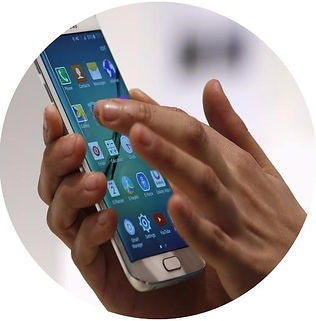
Tech Safety

We live in a world of constant technology use and lots of sharing. Technology has made it easier for families, friends, co-workers, and long-lost classmates to connect, and our online lives are just as important to us as our offline ones.
But what you share doesn’t always stay within those circles and can be shared much more broadly than expected. Sometimes our technology gets out of our control.
Abusers often use technology to keep track of and control survivors. Below are some tips to increase your online safety.
Adapted from and in partnership with: National Network To End Domestic Violence –Safety Net Project – techsafety.org.
10 Easy Steps To Maximize Tech Safety
1.
Log Out Of Accounts & Apps
This is easy to overlook! Uncheck the "keep me logged in" feature and don't allow the web browser to remember your password to automatically log you in. This is especially important if you're using someone else's device.
2.
Use Strong Passwords
The best passwords are at least 12 – 15 characters long, and can contain letters, numbers and symbols – which sounds like a lot. But remember – the important part is length! Lowercase letters on their own are just as fine as mixing it up with numbers and symbols, as long as the password is long enough.
3.
Review Privacy Settings
Review the privacy settings on all your online accounts, particularly your social media ones. Most sites allow users to limit what others see, whether it’s status updates or profile information.
4.
Minimize Location Sharing
Smart phones have GPS location capability and you could be sharing your location without even knowing it. You can control which app has access to your location by turning off that option through your smart phone. (Most phones have location privacy options in the settings.) Some social network sites also allow you to manage your location privacy through the site’s privacy settings.
5.
No Location Coordinates
When you take a picture on your smart phone, you could inadvertently share your location. That means that the selfie you just posted and uploaded online could contain your exact GPS coordinates. Turn off that capability through the privacy setting on your camera app. Don’t forget that even if you turned off the location option for your camera app, the photo sharing app that you’re using may share your location.
6.
Connecting Social Media
You can connect your Instagram to your Facebook or your Foursquare account to other social networks and that may make it easier to update them all with just one click. But that also means that a lot more people will have access to lots of info about you. It also makes it more difficult to lock down your privacy. So be thoughtful about which social media accounts you connect.
7.
Free Wireless Networks
Free internet is always awesome but be careful. But you pay for it by being more vulnerable to risks. Using open wireless networks at your local coffee shop can leave you susceptible to hackers accessing your private information. If your personal wireless network doesn’t have a password on it, set up a password for it now.
8.
Use HTTPS Everywhere
Not all websites are created equal. Some sites are more vulnerable to viruses, which makes your computer/tablet more vulnerable. However, some sites have a secure version – you can tell by looking at the link in the URL address bar. If it starts with https, it’s a secure page vs. http, which is just a normal page.
9.
Use Incognito Browsing
Currently, Google Chrome, Mozilla Firefox, and Microsoft Explorer allow you to browse privately. Basically, privately browsing means that someone can’t open your web browser after you’ve used it and go through the history to see what you’ve been up to. Keep in mind though that you have to close the browser to erase your history. If you leave it open, users after you can still see your browsing history.
10.
Use More Than One Email
Email addresses are free, so have as many as you want! Using different emails for different accounts is safer because if someone guesses one of your email + password combo, they don’t have access to all your accounts.
We Are Here For You!
Our certified and compassionate advocates are here for survivors, family and friends.

-
You can talk, text or chat with an advocate 24/7.
-
The conversation is completely confidential.
-
Your advocate can help you asses your tech safety and help you create a tech safety plan.
Tech Safety Resources

Techsafety.org is managed by the Safety Net Project at the National Network to End Domestic Violence (NNEDV).
This extensive resource discusses technology, privacy, and safety in the context of intimate partner violence, sexual assault, and violence against women
Technology Safety & Privacy: A Toolkit for Survivors
This online toolkit includes extensive resources from technology safety planning, to cell phone tips, instructional videos, online safety tips and information about spyware/stalkerware.
Assessing for Technology Abuse and Privacy Concerns
Are you concerned that your privacy may be compromised? This resource can assist you in determining if your safety is at risk.
Assessing For Technology Misuse And Privacy Concerns With Sexual Assault Survivors
Offenders often misuse technology in order to commit, and cover up, sexual assault. This page helps is tracking the digital trail with helpful questions.
Are you concerned about the safety of your apps? Did you know there are apps especially for survivors? Check out the app safety center!
Safety Net Device Applications
These apps are vetted and approved by NNEDV. The Tech Safety App helps identify technology-facilitated abuse and DocuSAFE is a tool that can help document abuse, store that documentation and share the documentation with trusted contacts.
Keeping your teen safe online is vitally important! MyTutor has provided a detailed list of the most popular apps among teens which includes pros/cons.


